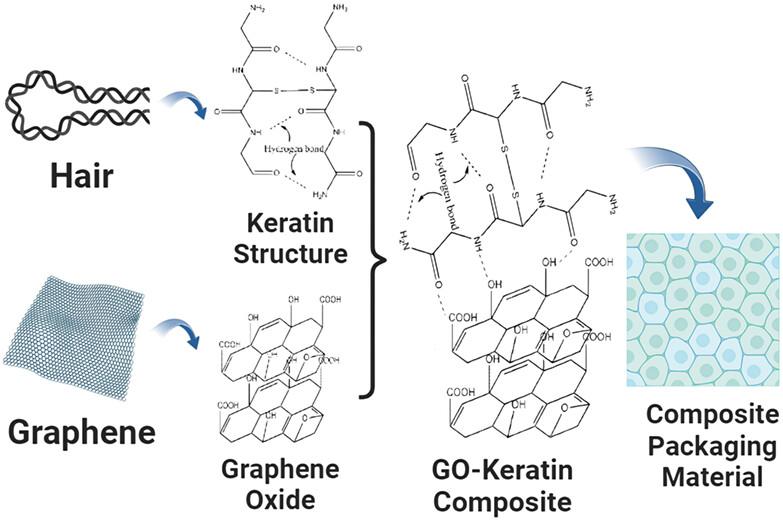求助PDF
{"title":"Biodegradable composite from discarded hair keratin and graphene oxide with improved mechanical, thermal and barrier properties: an eco-friendly solution to waste materials","authors":"Md Ashikur Rahaman Noyon, Md. Elias Uddin, Thuhin Kumar Dey, Mamun Jamal, Gokulkumar Sivanantham, Rashedul Islam","doi":"10.1002/pi.6586","DOIUrl":null,"url":null,"abstract":"<p>In recent years, there has been a growing concern to counter environmental pollution, and as a result the development of biodegradable materials in various applications has become a major focus. This study aimed to fabricate a biodegradable composite by utilizing discarded hair keratin from beamhouse processing in leather production along with incorporating graphene oxide (GO) to reduce pollution. The composite was prepared using a simple solution mixing method, where the amino functional group of keratin and the carboxyl group of GO were covalently bonded under a redox system. Various analyses, including UV–visible spectroscopy, Fourier transform infrared spectroscopy, Raman spectroscopy, SEM, biodegradability and oxygen gas transmittance rate, were carried out to evaluate the composite's structure and performance. The results demonstrated that GO was successfully integrated into the keratin matrix, with uniform dispersion of GO observed instead of agglomeration. The composite with the optimum ratio exhibited a 173.98% increase in tensile strength and a 33.52% decrease in elongation as well as improved thermal and biodegradation properties compared to pure keratin. Furthermore, the composite displayed significantly better gas barrier properties (39%) than pure keratin, which can be attributed to the reduction of intermolecular gaps through the composite's strong bonding. Hence, the keratin-GO composite is a cost-effective and biodegradable solution to waste materials, with potential use as a packaging material. © 2023 Society of Chemical Industry.</p>","PeriodicalId":20404,"journal":{"name":"Polymer International","volume":null,"pages":null},"PeriodicalIF":2.9000,"publicationDate":"2023-10-28","publicationTypes":"Journal Article","fieldsOfStudy":null,"isOpenAccess":false,"openAccessPdf":"","citationCount":"0","resultStr":null,"platform":"Semanticscholar","paperid":null,"PeriodicalName":"Polymer International","FirstCategoryId":"92","ListUrlMain":"https://onlinelibrary.wiley.com/doi/10.1002/pi.6586","RegionNum":4,"RegionCategory":"化学","ArticlePicture":[],"TitleCN":null,"AbstractTextCN":null,"PMCID":null,"EPubDate":"","PubModel":"","JCR":"Q2","JCRName":"POLYMER SCIENCE","Score":null,"Total":0}
引用次数: 0
引用
批量引用
Abstract
In recent years, there has been a growing concern to counter environmental pollution, and as a result the development of biodegradable materials in various applications has become a major focus. This study aimed to fabricate a biodegradable composite by utilizing discarded hair keratin from beamhouse processing in leather production along with incorporating graphene oxide (GO) to reduce pollution. The composite was prepared using a simple solution mixing method, where the amino functional group of keratin and the carboxyl group of GO were covalently bonded under a redox system. Various analyses, including UV–visible spectroscopy, Fourier transform infrared spectroscopy, Raman spectroscopy, SEM, biodegradability and oxygen gas transmittance rate, were carried out to evaluate the composite's structure and performance. The results demonstrated that GO was successfully integrated into the keratin matrix, with uniform dispersion of GO observed instead of agglomeration. The composite with the optimum ratio exhibited a 173.98% increase in tensile strength and a 33.52% decrease in elongation as well as improved thermal and biodegradation properties compared to pure keratin. Furthermore, the composite displayed significantly better gas barrier properties (39%) than pure keratin, which can be attributed to the reduction of intermolecular gaps through the composite's strong bonding. Hence, the keratin-GO composite is a cost-effective and biodegradable solution to waste materials, with potential use as a packaging material. © 2023 Society of Chemical Industry.
由废弃头发角蛋白和氧化石墨烯制成的可生物降解复合材料,具有更好的机械、热和阻隔性能:废弃材料的生态友好型解决方案
近年来,人们越来越关注环境污染问题,因此在各种应用中开发可生物降解材料已成为一大焦点。本研究的目的是利用皮革生产过程中束房加工过程中废弃的毛发角蛋白,结合氧化石墨烯(GO),制造一种可生物降解的复合材料,以减少污染。该复合材料采用简单的溶液混合法制备,在氧化还原体系下,角蛋白的氨基官能团与 GO 的羧基官能团共价键合。为了评估该复合材料的结构和性能,研究人员进行了各种分析,包括紫外可见光谱、傅立叶变换红外光谱、拉曼光谱、扫描电镜、生物降解性和氧气透过率。结果表明,GO 成功地融入了角蛋白基质中,并观察到 GO 的均匀分散而不是团聚。与纯角蛋白相比,最佳比例的复合材料的拉伸强度提高了 173.98%,伸长率降低了 33.52%,热性能和生物降解性能也得到了改善。此外,复合材料的气体阻隔性能(39%)明显优于纯角蛋白,这可归因于复合材料的强粘合性减少了分子间的间隙。因此,角蛋白-GO 复合材料是一种具有成本效益且可生物降解的废弃材料解决方案,有望用作包装材料。© 2023 化学工业协会。
本文章由计算机程序翻译,如有差异,请以英文原文为准。




